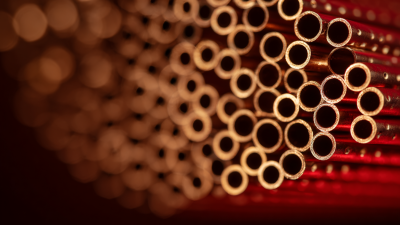Leave Your Message
In today's competitive packaging market, choosing the right packaging solution is crucial for maintaining product integrity and enhancing brand appeal. One of the most versatile options available is the Laminate Pouch, which has gained significant traction in various industries. According to a recent report by Smithers Pira, the global flexible packaging market is projected to reach $300 billion by 2024, with laminate pouches accounting for a substantial share due to their lightweight, durability, and barrier properties. These pouches not only offer superior protection against moisture, light, and oxygen but also contribute to sustainability efforts, as they can often be designed for recyclability. This article aims to guide businesses in selecting the best laminate pouch tailored to their specific packaging needs, ensuring they capitalize on the numerous advantages these pouches provide.

When selecting laminate pouches for your products, several critical factors come into play. First, consider the material composition. According to Technavio, the global flexible packaging market is projected to grow by $40 billion between 2021 and 2025, emphasizing the importance of choosing the right materials for durability and shelf-life. Look for pouches made from multi-layer laminates that provide excellent barrier properties against moisture, light, and oxygen, crucial for preserving product quality.
Another essential factor is the size and structure of the pouch. It’s vital to match the pouch dimensions to your specific product to prevent damage and ensure proper sealing. A report by Grand View Research indicates that the demand for custom sizes in packaging is on the rise, highlighting the significance of tailored solutions.
Tips: Always conduct sealing tests prior to mass production to ensure the integrity of your packaging. Additionally, consider using pouches with resealable features for consumer convenience, as studies show that products with resealable options have a 15% higher retention rate among consumers. Lastly, keep sustainability in mind; choose eco-friendly materials, as the demand for sustainable packaging solutions is becoming increasingly imperative in today's market.
When selecting the best laminate pouch for your packaging needs, understanding the various types and their specific applications is crucial. The U.S. laminating adhesives market is segmented by resin type, primarily including polyurethane and acrylic options, which are pivotal in determining the durability and functionality of laminate pouches. For instance, polyurethane-based laminates offer enhanced flexibility and resistance to temperature variations, making them suitable for food packaging where preservation and freshness are key.
Another factor to consider is the technology used in the laminate pouches. Solvent-based adhesives are popular for their strong bonding capability, particularly in applications that demand robust moisture barriers, while water-based and UV-cured options offer environmentally friendly alternatives without compromising on adhesive strength. According to industry reports, the laminating adhesive market is projected to reach significant growth, primarily driven by increasing demand for high-quality packaging materials across diverse sectors, including food, pharmaceuticals, and consumer goods. Understanding these nuances ensures that you can choose the right laminate pouch tailored to your specific packaging requirements.

When selecting laminate pouches for your packaging needs, one critical factor to consider is thickness. The thickness of a laminate pouch can greatly influence its durability and protective qualities. Thicker pouches typically offer better resistance against tears, moisture, and other environmental factors, making them ideal for safeguarding important documents, photos, or sensitive items. If you’re looking to preserve certificates or cherished family pictures, opting for a thicker laminate can prevent damage from spills or wear over time.
Moreover, the thickness plays a vital role in the overall seal integrity of the package. In flexible packaging, the heat-sealing process must be effective to ensure that the contents remain safe from air and moisture infiltration. A thicker laminate pouch can provide a more secure seal, reducing the risk of compromised protection. Understanding these characteristics will enable you to make informed choices about the right laminate pouch for your specific application, whether it’s for everyday documents or special keepsakes.
This chart illustrates the various thickness levels (in microns) for laminate pouches. Understanding these thicknesses is crucial when selecting the best pouch for your packaging needs, as it affects durability, protection, and overall performance of the packaging.
When selecting the ideal laminate pouch for your packaging needs, it's crucial to strike a balance between cost and quality. According to the Packaging Association, nearly 70% of packaging professionals prioritize quality over cost, understanding that superior materials can significantly enhance product shelf life and reduce waste. High-quality laminate pouches not only provide barrier protection against moisture and oxygen but also improve the aesthetic appeal of the product, potentially boosting customer engagement and sales.

Tips for choosing the right laminate pouch include assessing the specific needs of your product. For instance, if your items require a longer shelf life, investing in pouches with enhanced barrier properties may be worth the extra cost. Additionally, consider sourcing from suppliers that offer test data on their materials, as this can provide insight into durability and resistance.
It's also advisable to review your projected packaging output. A report from Smithers Pira indicates that businesses may experience a 20-30% cost reduction through bulk purchasing. Therefore, weighing the upfront costs against potential savings in production and spoilage can guide you toward the best laminate pouch option that meets both budget and quality requirements.
When selecting laminate pouches for your packaging needs, sustainability should be a primary consideration. Eco-friendly options not only reflect your brand's values but also appeal to increasingly environmentally-conscious consumers. One option to explore is recyclable laminates. These pouches can be processed at select facilities, reducing landfill waste and promoting a circular economy. Brands can also look into biodegradable laminates, made from materials that break down naturally over time, minimizing their environmental footprint.
Another effective tip is to consider pouches made from sustainable materials such as plant-based bioplastics. These alternatives use renewable resources, which can significantly lessen carbon emissions compared to traditional petroleum-based plastics. Additionally, opting for water-based inks during the printing process can further enhance the eco-friendliness of your packaging, as they contain fewer volatile organic compounds (VOCs) than their solvent-based counterparts, keeping both the environment and consumer health in mind.
Lastly, prioritize suppliers that follow sustainable practices throughout their production process. Choosing manufacturers that are committed to reducing waste and energy consumption helps ensure that the entire lifecycle of your packaging is eco-conscious. By taking these steps, you can make a meaningful impact on the environment while meeting your packaging needs.






